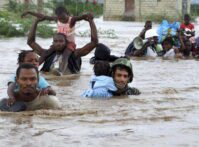Forty percent of the world’s population –
2.6 billion people – do not have access to toilets, and some in the international aid community are finally dispensing with the euphemisms and calling this sanitation crisis what it is: “shit.”
In “
The World’s Toilet Crisis” (trailer above),
Adam Yamaguchi sets off in an episode of Current TV’s
Vanguard program to tell the story of “the deadliest killer in the world…something no one wants to talk about.” All around the developing world, thanks in part to rapid population growth and poor development and environmental standards, “people are literally eating their own shit,” he said.
His journey takes him to India, where more people own cell phones, than toilets. The 55 percent of Indians who practice open defecation have contributed to another grim statistic: an estimated 840,000 children under the age of five die in India each year from diarrheal diseases.
India’s water quality is especially affected by lack of sanitation. In the documentary, Yamaguchi visits the Yamuna River, which is Delhi’s primary source of drinking water, and has become a “giant toilet” literally bubbling with methane gas. This phenomenon is not unique to India. Approximately 80 percent of sewage in developing countries goes untreated, polluting local water resources.
But it is women who feel the effects of lack of access to clean water and toilets most keenly. In 72 percent of households around the world, women are the primary water collectors, often travelling long distances for drinkable water. They face shame and harassment when going to the bathroom, causing them to suppress their need until dark, causing negative health effects. Waiting until nightfall also means that when women openly defecate, they often face molestation, violence, and rape. Teenage girls also often drop out of school once they begin to menstruate because toilets are not private, unsafe, or are simply nonexistent.
Reflecting on his motivations for making the documentary, Yamaguchi said that in order to expose this “global public health crisis,” he needed to be as graphic, shocking, and disgusting as possible.If you’re not grossed out by, or incensed by the fact that there is shit everywhere, you’re not really moved to act or change your ways. And that’s ultimately what’s happened in many places in the world. It’s a normal fact of life. You see it everywhere, and you think nothing of it. There are causes out there that are deep sexy causes or marketable causes. Shit or toilets – not the most marketable thing in the world.
“The World’s Toilet Crisis” forms part of a broader trend among sanitation advocates to use crude language to address a problem the international health and development community has traditionally shied away from talking about directly.
Tales of shit: Community-Led Total Sanitation in Africa, published shortly before World Toilet Day by the International Institute for Environment and Development, takes an equally direct approach to sanitation.
Community-Led Total Sanitation (CLTS) is an approach begun with great success by Dr. Kamal Kar in Bangladesh that relies on “triggering” to change community behavior. The report, which is prefaced by a three-page “International Glossary of Shit” listing the words for shit in other languages, emphasizes the need to “explicitly [talk] about and [make] visible the shit that is normally hidden beneath taboos and polite language.” By almost literally thrusting people’s shit right under their noses, communities learn what they have been ignoring: that they are “eating each others’ shit.”
Traditional sanitation programs often fail because “a high proportion of latrines constructed with subsidies are never used as toilets, but as storage space, animal shelters, or prayer rooms – the buildings are too high quality to be wasted on toilets!” says the report. CLTS, on the other hand, focuses on changing behavior at the community, rather than the individual level to create sustainable change that responds and adapts to a community’s distinct culture and needs.
“The World’s Toilet Crisis” shows the promise CLTS has of meeting the needs of the billions without toilets. In East Java, Yamaguchi joins a community leader to collect a “specimen” from a well-traveled river bank near the town, which he proceeds to show to a group of women in the town who are, predictably, revolted. The community then takes collective action to become “open-defecation free” and invest in toilets.
“The World’s Toilet Crisis” is not easy to watch, nor was it easy to film – seven minutes in, Yamaguchi vomits on the banks of the polluted Yamuna River. Disgust, however, is central to raising awareness and affecting change on both the community and global levels. As Yamaguchi explains, “You’re going to get grossed out by seeing this piece, and that’s part of the point.”
Sources: Community-Led Total Sanitation, Current TV, Earth Times, IIED, Water.org, World Toilet Organization, WHO, United Nations University.
Video Credit: “The World’s Toilet Crisis – Vanguard Trailer,” courtesy of Current TV’s Vanguard.
 A Publication of the Stimson Center.
A Publication of the Stimson Center.






